We've made some good progress - so time again to make another summary 
1. The Rotator Chip
The only issue left right now is that we got some tearing when using the rotator chip.
For those who don't know what that is: When writing to and reading from the framebuffer is not properly synchronized, the picture you can see of the LCD is from two different frames (i.e. top half frame 1, bottom half frame 2).
This gives an effect as if the screen is torn into two halfs when you got videos or games with fast movement.
To prevent this, you need to synchronize the OMAP5 with the SSD (rotator chip) so that the framebuffer is not being overwritten while it's being read.
This is a bit more software work than we thought. There's a special signal line from the SSD to the OMAP that is being used to synchronize both devices, but that only works in MIPI Command Mode, whereas we are running the OMAP5 using MIPI Video Mode.
So as a solution, we'd either need to change the existing driver somehow so that the TE line can be used in Video Mode as well OR try to use the OMAP5 in Command Mode instead of Video Mode.
We don't know yet which one of those two will be easier to achieve, but both of them might be a bit time consuming.
Nevertheless, the hardware itself is working fine, so Nikolaus now concentrates on the remaining hardware - fixing the software can happen while we're waiting for the mass production to start (or even afterwards).
So the display including the rotator works fine, but we currently have some tearing issues with fast moving content until we improved the driver.
2. The case
Basically, the case is finished.
I've printed the last revision and am just waiting for some final prototype boards to assemble everything - and once I confirm that everything fits, the real mold is being created.
I expect it to be finished about October.
Of course, as soon as I assemble it, I'll create a video of it!
3. The keyboard
The keyboard design is basically finished.
The normal keys will be surrounded by a bit of transparent silicone mat (but will be 0,1mm higher), which will give a nice feeling and also light up the key surroundings as well as the characters.
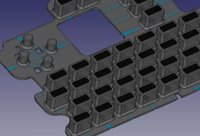
The only exception will be the gaming buttons:
Here, the plastic of the buttons will be glued on top of the mat, so they feel like standard gaming buttons (yes, this has changed within the last few days).
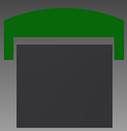
Mold production here should start within the next week and will take approximately one month.
The means: Yep, there's no way I can run away from reading the keyboard layout threads anymore
4. The hardware
Nikolaus was working on the rotator chip as well, to find out what was hardware and software related.
As you probably can imagine, fixing hardware later will be hard, but fixing software is possible
A week ago, Nikolaus restarted the work on the hardware.
Within this week, he created 106 traces within 15 hours work (so about 7 traces per hour).

410 traces are left to be created - so if he continues in the same pace, the CPU board will be finished in about 15 days.
Could be a bit faster as well though (some non-critical traces could be made using the auto-router), but we'll see.
Our goal is to have the full hardware finished within July, so we actually have real prototypes ready to show at the GamesCom in August.
Yep, if you're visiting there, you might be able to play on a real Pyra prototype!
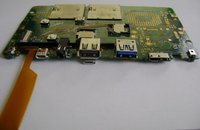
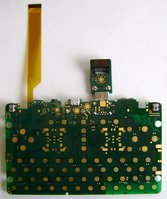
Shortly after that preorders will start (unless we find some major issue with the prototype) - with a lot of videos following.
Well, that's what we're planning anyways - let's hope we can keep that and it will work out!
Nikolaus also started to work on the e-SATA adaptor which plugs into our USB port for those who want to connect a SATA device to the Pyra.
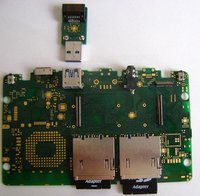
Some good progress, I'd say
Hopefully back with more good news soon.
1. The Rotator Chip
The only issue left right now is that we got some tearing when using the rotator chip.
For those who don't know what that is: When writing to and reading from the framebuffer is not properly synchronized, the picture you can see of the LCD is from two different frames (i.e. top half frame 1, bottom half frame 2).
This gives an effect as if the screen is torn into two halfs when you got videos or games with fast movement.
To prevent this, you need to synchronize the OMAP5 with the SSD (rotator chip) so that the framebuffer is not being overwritten while it's being read.
This is a bit more software work than we thought. There's a special signal line from the SSD to the OMAP that is being used to synchronize both devices, but that only works in MIPI Command Mode, whereas we are running the OMAP5 using MIPI Video Mode.
So as a solution, we'd either need to change the existing driver somehow so that the TE line can be used in Video Mode as well OR try to use the OMAP5 in Command Mode instead of Video Mode.
We don't know yet which one of those two will be easier to achieve, but both of them might be a bit time consuming.
Nevertheless, the hardware itself is working fine, so Nikolaus now concentrates on the remaining hardware - fixing the software can happen while we're waiting for the mass production to start (or even afterwards).
So the display including the rotator works fine, but we currently have some tearing issues with fast moving content until we improved the driver.
2. The case
Basically, the case is finished.
I've printed the last revision and am just waiting for some final prototype boards to assemble everything - and once I confirm that everything fits, the real mold is being created.
I expect it to be finished about October.
Of course, as soon as I assemble it, I'll create a video of it!
3. The keyboard
The keyboard design is basically finished.
The normal keys will be surrounded by a bit of transparent silicone mat (but will be 0,1mm higher), which will give a nice feeling and also light up the key surroundings as well as the characters.

The only exception will be the gaming buttons:
Here, the plastic of the buttons will be glued on top of the mat, so they feel like standard gaming buttons (yes, this has changed within the last few days).

Mold production here should start within the next week and will take approximately one month.
The means: Yep, there's no way I can run away from reading the keyboard layout threads anymore
4. The hardware
Nikolaus was working on the rotator chip as well, to find out what was hardware and software related.
As you probably can imagine, fixing hardware later will be hard, but fixing software is possible
A week ago, Nikolaus restarted the work on the hardware.
Within this week, he created 106 traces within 15 hours work (so about 7 traces per hour).

410 traces are left to be created - so if he continues in the same pace, the CPU board will be finished in about 15 days.
Could be a bit faster as well though (some non-critical traces could be made using the auto-router), but we'll see.
Our goal is to have the full hardware finished within July, so we actually have real prototypes ready to show at the GamesCom in August.
Yep, if you're visiting there, you might be able to play on a real Pyra prototype!


Shortly after that preorders will start (unless we find some major issue with the prototype) - with a lot of videos following.
Well, that's what we're planning anyways - let's hope we can keep that and it will work out!
Nikolaus also started to work on the e-SATA adaptor which plugs into our USB port for those who want to connect a SATA device to the Pyra.

Some good progress, I'd say
Hopefully back with more good news soon.

